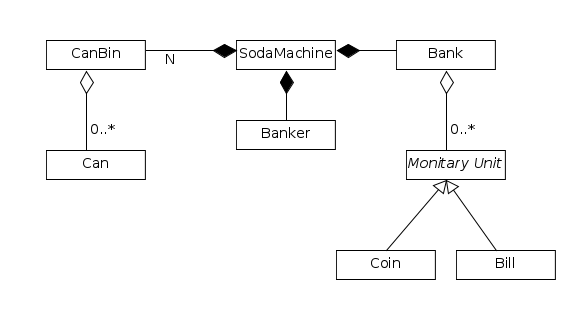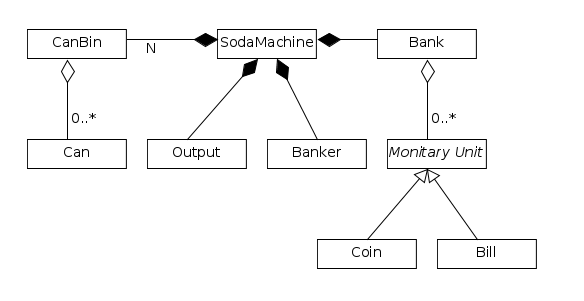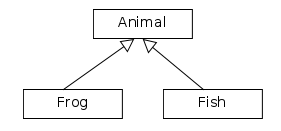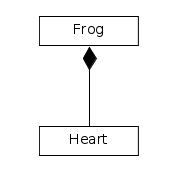Intro to Design
- Read Chapter 5.
- Objects
- We already have that an class consists of
- Member data
- Member functions.
- These are some times called properties and behaviors.
- An objects are instances of classes
- The have a state which is the exact value of the member data.
- Object properties are the state.
- A class is a template for building an object.
- His discussion of 124-126 is headed towards OO terminology. I don't think we need that yet.
- One thing to note, is that he discusses Components
- I don't see this in most discussions directly.
- But it introduces the notion that objects are composed of other objects.
- We started on that last time
- My soda machine will be composed of
- An array of can bins
- Which will contain cans.
- A can will be a basic object.
- A Bank
- Which will consist of an array of MonitaryUnits
- These can be either a coin or a bill, or even perhaps a credit card in the future.
- A bank
- Responsible for handling the money transactions.
- This may be expanded later.
- I might need to add user interface objects
- But this will do for now.
-

- Picking the objects
- They should have behaviors and properties
- 7 is probably not an object, it doesn't really have behaviors, only properties.
- InsertionSort is probably not an object, it doesn't have properties, only behaviors.
- They should have "crisp" boundaries.
- I moved the banker out of the bank.
- The bank is responsible for storing money.
- The banker is responsible
- Tracking the money deposited.
- Making change.
- The bank is a holder, I can use it many places.
- I was toying with a parser object
- It takes a string (command) and returns an action and an array of arguments.
- "Deposit 25c" would become DEPOSIT (enumerated constant), and a Coin (value 25, currency "USD"), in an array of size 1.
- This is possibly a valid object, but it could equally be just a function.
- I think this would not be an appropriate object. But perhaps I will change my mind later.
- But I know that this is not part of my soda machine.
- By the button push actions, the input is already parsed.
- I don't want to tie my soda machine to a text interface.
- That also covers the input objects in the soda machine
- There might be a button class, but that is a physical object what would call the soda machine button press method.
- There is a Model-View-Controller pattern that suggests this is the proper way to do this.
- Your mileage may vary here.
- I think I would probably add a output device class
- This will take a coin, can or message and display it.
- Later this could be replaced with a set of physical mechanisms
-

- Some Relationships in this diagram.
- OOD and UML has many different relationships they show.
- We will discuss three now.
- Inheritance
- One object is derived from another.
- It receives the properties/behaviors of the parent
- Plus it can add additional properties/behaviors.
- This is a "is-a" relationship.
- A frog is an animal
- A fish is an animal
- Each has common properties such as age, alive, ....
- Each has common behaviors such as eat, look
- Each has a move behavior, but it will be different for each subclass/ derived class.
- Each might have unique behaviors and properties.
-

- This is a fundamental requirement for Object Oriented
- We made coins/bills derived classes of the MonityUnit class.
- Because of this we will be able to return an array of MonittaryUnits, made up of either type.
- We can also extend the monitaryUnit to include other types.
- I am not sure that there is sufficient difference in a coin or bill to require the subclasses.
- Right now they both have a value and a currency.
- But if we add credit cards, there is a major difference.
- If we were designing a generic vending machine, we might build a VendingUnit in place of a Can.
- With inheritance we can
- Add functionality
- A frog is an animal which can move via walk or hop or swim.
- Replace Functionality
- A fish's move method is replaced by a swim method.
- Add/override Properties
- inheritance is used to support polymorphism
- We can have an array of monitaryUnits composed of either coins or bills.
- Each retains their own characteristics.
- But we can add up the value of all of the items we have with a single loop.
- We don't need a totalCons and a totalBills loop.
- Aggregation (composition)
- This is a "has-a" relationship where existence is dependent on the objects.
- A frog has a heart.
- The heart can not exist without the frog.
- Ok, perhaps in some biology class scope.
- But not in the "frog pond" world of my game.
-

- The relationships can have multiplicities
-
| Multiplicity | Meaning |
|---|
| N | Exactly N instances |
| 0..1 | Zero or one instance |
| 0..* | Zero or more instances |
| N..* | N or more instances |
| none given | 1 to 1 |
-

- Notice above
- A soda machine has a bank, which can not exist outside of a soda machine.
- The same is true for a Banker, Output and CanBin
- But not coins and cans.
- Aggregation (Shared aggregation)
- Another Has-a relationship
- In a shared aggregation, items can exist without each other.
- This make sense in our soda machine.
- A can of soda exists after it has been vended.
- A coin exists outside of the bank.
-

- A frog is in 0 or 1 pond
- A pond has zero or more frogs.





